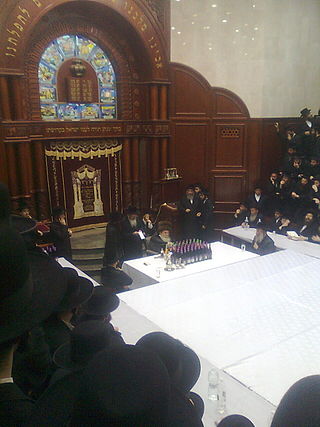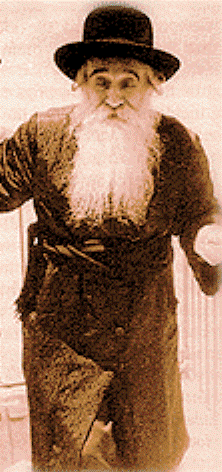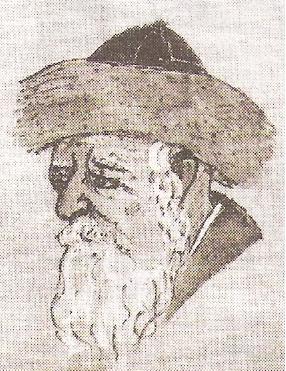
Chernobyl is a Hasidic dynasty that was founded by Grand Rabbi Menachem Nachum Twersky, known by the name of his work as the Meor Einayim. The dynasty is named after the northern Ukrainian town of Chernobyl, where Rabbi Nachum served as the maggid. The lineage has continued to exist to this day, although not always with the name Chernobyl. Today there are several rebbes named Chernobyl. The central court is in Bnei Brak, headed by Rabbi Menachem Nachum Twersky.

Chortkov is a Hasidic dynasty that originated in Chortkiv, present-day Ukraine. The town was part of the Tarnopol Voivodeship of the Second Polish Republic until September 1939. The town itself was founded in 1522 by Polish King Sigismund I the Old. The dynasty had a large following before the Second World War, but most of its adherents were murdered in the Holocaust.

Ruzhin is the name of a Hasidic dynasty founded by Rabbi Yisroel Friedman (1796–1850) in the town of Ruzhyn, Ukraine, today an urban-type settlement in Zhytomyr Oblast, Ukraine.
Boyan is a Hasidic dynasty named after the town of Boiany in the historic region of Bukovina, now in Ukraine. The Hasidut is headquartered in Jerusalem, with communities in Beitar Ilit, Bnei Brak, Manchester, Australia, Beit Shemesh, London, Antwerp, Manhattan, Brooklyn, Los Angeles, Monsey, Lakewood, and Atlanta. Boyan is one of the branches of the Ruzhiner dynasty, together with Bohush, Chortkov, Husiatyn, Sadigura, Kapishnitz, Vaslui and Shtefanesht.

Sadigura is a Hasidic dynasty named for the city of Sadhora, Bukovina, which belonged to Austria. The dynasty began in 1850 with Rabbi Avrohom Yaakov Friedman, a son of Rabbi Yisrael Friedman of Ruzhyn, and was based in Sadigura until 1914. During the interwar period the dynasty was led by Rebbes in Vienna and Przemyśl, Poland, and on the eve of World War II was transplanted to Israel, where it thrives to this day.
Boiany is a village in Chernivtsi Raion, Chernivtsi Oblast (province) of western Ukraine. It is located close to Sadagura in the historic region of Bukovina. It hosts the administration of Boiany rural hromada, one of the hromadas of Ukraine.
Sadhora is a settlement in Ukraine, now a Sadhirskyi District of Chernivtsi city, which is located 6 km from the city center. Previously, it was an independent town.

Moetzes Gedolei HaTorah is the supreme rabbinical policy-making council of the Agudat Yisrael and Degel HaTorah movements in Israel; and of Agudath Israel of America in the United States. Members are usually prestigious Roshei Yeshiva or Hasidic rebbes, who are also usually regarded by many Haredi Jews to be the Gedolim ("great/est") sages of Torah Judaism. Before the Holocaust, it was the supreme authority for the World Agudath Israel in Europe.

Israel Friedman of Ruzhyn, also called Israel Ruzhin, was a Hasidic rebbe in 19th-century Ukraine and Austria. Known as Der Heiliger Ruzhiner, he conducted his court with regal pomp and splendor. Tsar Nicholas I of Russia, who was said to be jealous of the Rebbe's wealth and influence, had the Rebbe imprisoned for nearly two years on an unsubstantiated murder charge. After his release, the Rebbe fled to Austria, where he re-established his court in Sadigura, Bukovina, attracted thousands of Hasidim, provided for the Hasidic community in Israel, and inaugurated the construction of the Tiferet Yisrael Synagogue in the Old City of Jerusalem.
Bohush is a Hasidic dynasty named for the town of Buhuși, Romania. The dynasty began in the mid-nineteenth century with Rabbi Yitzchok Friedman of Bohush, the eldest grandson of Rabbi Yisrael Friedman of Ruzhyn, and was based in that town until 1951, when his great-grandson, Rabbi Yitzchok Friedman of Bohush-Tel Aviv, moved the dynasty to Tel Aviv. In 1987 the Bohush beis medrash was transferred to Bnei Brak, where the dynasty is led today by Rabbi Yaakov Mendel Friedman, a great-great-grandson of the first Bohusher Rebbe.


Shtefanesht was a Hasidic dynasty named for the town of Ștefănești, Romania. It was one of the branches of the Ruzhiner dynasty, together with Bohush, Boyan, Chortkov, Husiatyn, and Sadigura. The dynasty lasted from 1851 to 1933 and had only two Rebbes: Rabbi Menachem Nochum Friedman, a son of the Ruzhiner Rebbe, and Rabbi Avrohom Mattisyohu Friedman, the only son of Rabbi Menachem Nochum. During the latter's reign, Ștefănești became one of the most important Hasidic centers in Eastern Europe.

Shmuel Yitzchok Bornsztain, also spelled Borenstein or Bernstein, is the sixth Rebbe of the Sochatchov Hasidic dynasty.

Rabbi Yitzchok Friedman was founder and first Rebbe of the Boyan Hasidic dynasty. He was known as the Pachad Yitzchok.

Mordechai Shlomo Friedman, sometimes called Solomon Mordecai Friedman, was the Boyaner Rebbe of New York for over 40 years. In 1927 he left Europe to become one of the first Hasidic Rebbes in America, establishing his court on the Lower East Side of New York City and attracting many American Jewish youth with his charismatic and warm personality. He also played a role in American Jewish leadership with positions on Agudath Israel of America, the Moetzes Gedolei HaTorah, and Holocaust rescue organizations. In 1957 he built the flagship Ruzhiner yeshiva, Tiferet Yisroel, at the top of Malkhei Yisrael Street in Jerusalem.

Avrohom Yaakov Friedman was the first Rebbe of the Sadigura Hasidic dynasty. He lived in the palatial home constructed by his father, Rabbi Yisrael Friedman of Ruzhyn, who fled to the Austrian town of Sadhora due to persecution by the Russian Tsar. He maintained his father's extravagant lifestyle while immersing himself in Torah study and mysticism. He was considered the greatest Rebbe of his era, attracting hundreds of thousands of Jews as well as prominent Christian leaders to his court.

Avrohom Yaakov Friedman, in English also spelled Abraham Jacob Friedman was the third Rebbe of the Sadigura Hasidic dynasty. He was a prominent Jewish leader in Vienna in the interwar period and in the nascent State of Israel, where he established his court in Tel Aviv. He was one of the first members of Agudat Israel and occupied a seat on the Moetzes Gedolei HaTorah.

Avrohom Yaakov Friedman was the fifth Rebbe of the Sadigura Hasidic dynasty. In 1979 he succeeded his father, the fourth Sadigura Rebbe, and took his seat on the Moetzes Gedolei HaTorah. He oversaw the growth of Sadigura communities in Israel and in London, Antwerp, and New York City.

Yisroel Moshe Friedman was the sixth Rebbe of the Sadigura Hasidic dynasty. He led his court from Bnei Brak, Israel.
Rabbi Sholom Shachne of Prohobisht, also known as "Rabbi Sholom the Great" was a Ukrainian rabbi and father of Rabbi Yisroel Friedman of Ruzhin.














